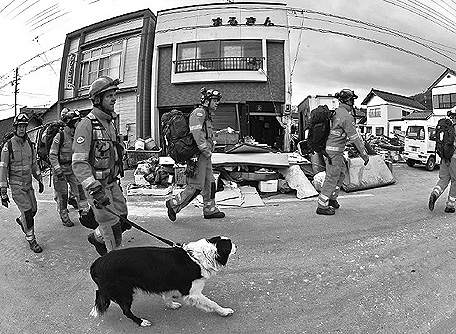Japan's Official Development Assistance White Paper 2011
Part I Overcoming the Earthquake — ODA and Our Bond with the World —
Chapter 1 The Earthquake and Japan in the World

A British rescue team conducts a search in Ofunato City, Iwate Prefecture, on March 15, 2011
On March 11, 2011, Japan suffered an earthquake and tsunami of unprecedented proportion. The Great East Japan Earthquake was measured at magnitude 9.0, the largest ever recorded in Japan's history. The earthquake and the resulting tsunami struck the Pacific coast of the Tohoku and Kanto regions with such devastating force that it dramatically changed the face of the seaside landscape. As of December 13, 2011, the number of dead and missing as a result of the Great East Japan Earthquake has reached approximately 20,000 people, with over 350,000 homes and other buildings completely or partially destroyed. In addition, damage from the earthquake and tsunami at Tokyo Electric Power's Fukushima Daiichi Nuclear Power Station led to a serious nuclear accident, forcing many of the residents of surrounding areas into long-term evacuation. An uncountable amount of support, messages of encouragement, and many donations of money and goods, etc., have flowed from countries and regions around the world into the affected areas that suffered this enormous damage, and to Japan in general. It can be assumed that behind this is a sense of trust and gratitude toward Japan that has been fostered by a variety of international cooperation in which Japan has participated in the past. Japan has a deep responsibility to respond to the trust and solidarity shown toward it by the international community, and as a member of the world, to live up to its bond with the world, by overcoming the earthquake and tsunami, and continuing proactively with ODA (Note 1) and other contributions to international efforts.
Notes:
(1) ODA: Official Development Assistance
